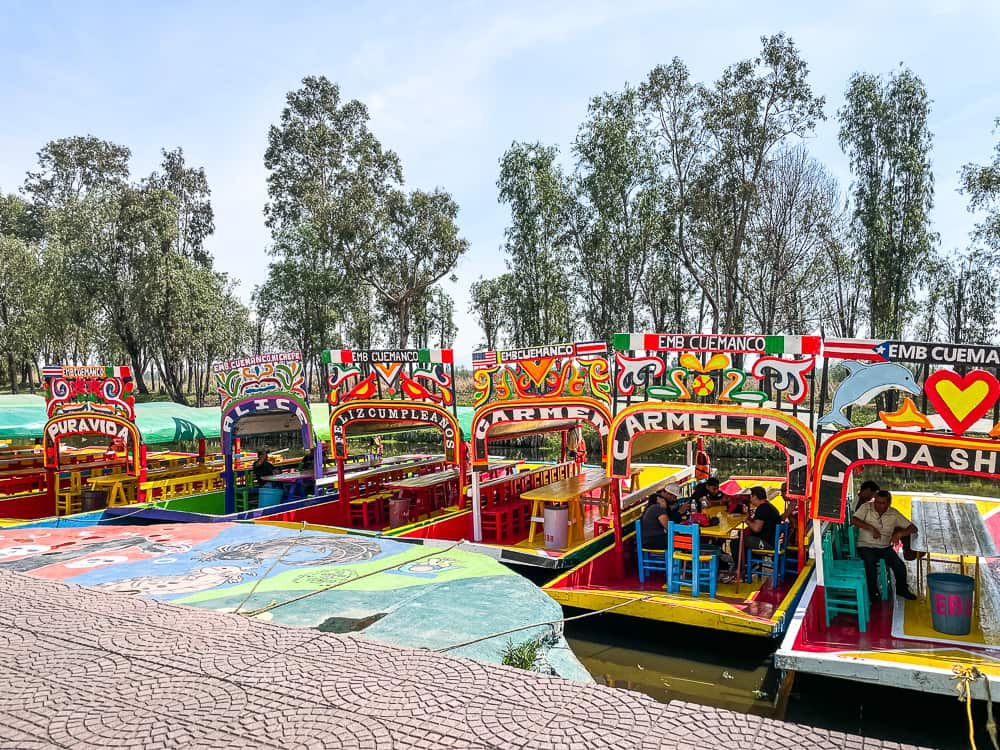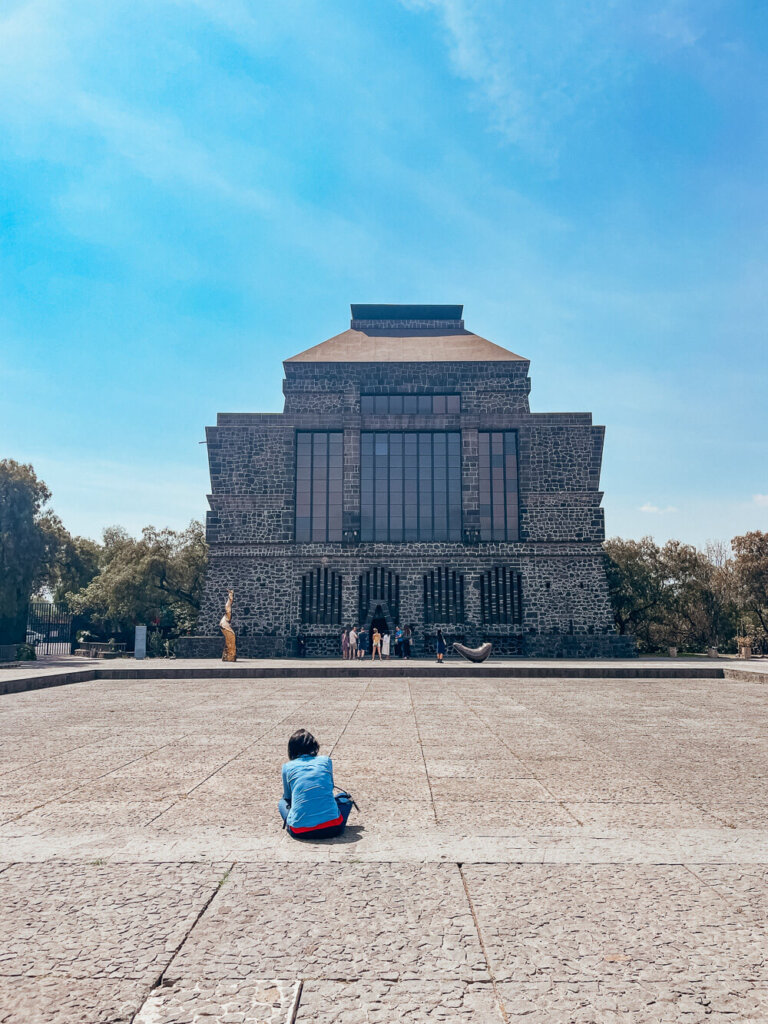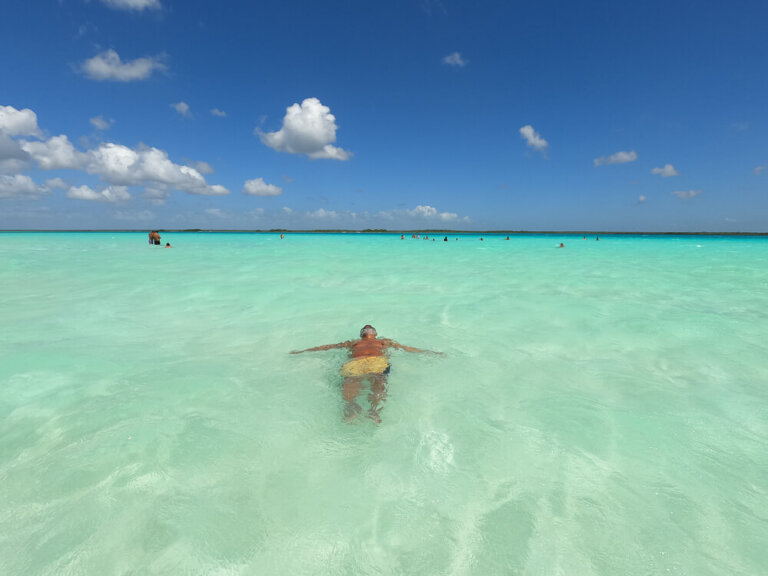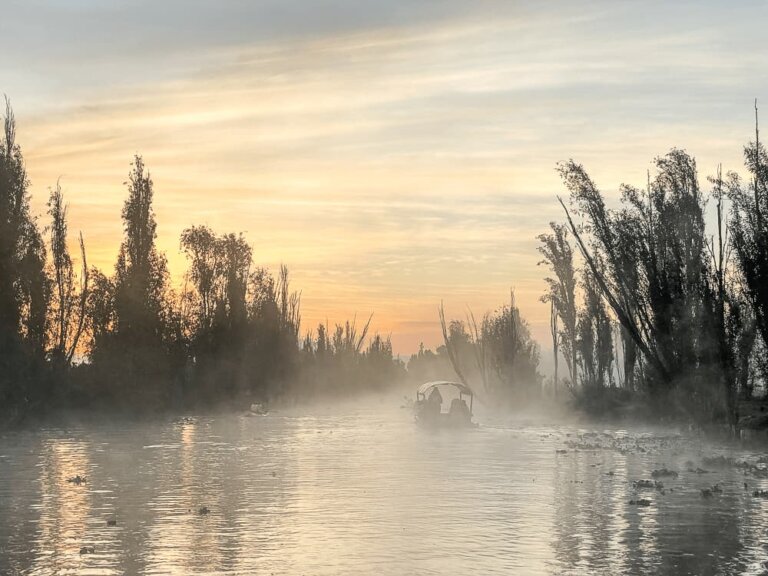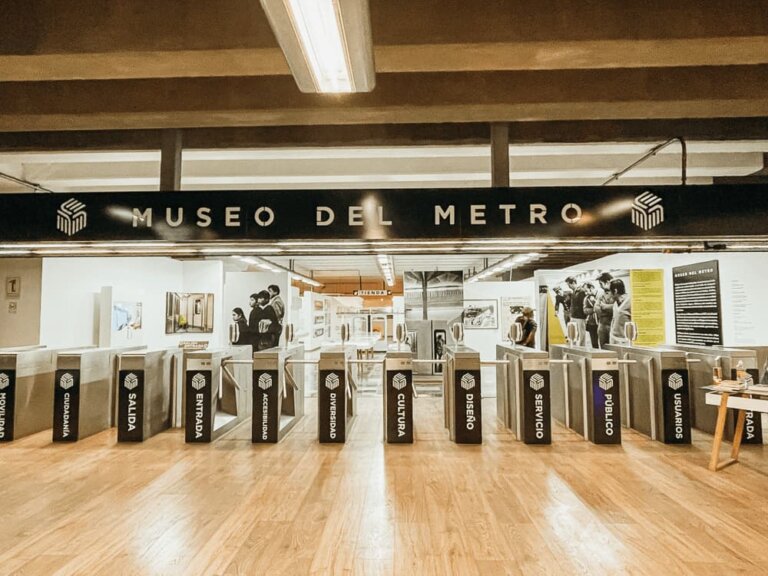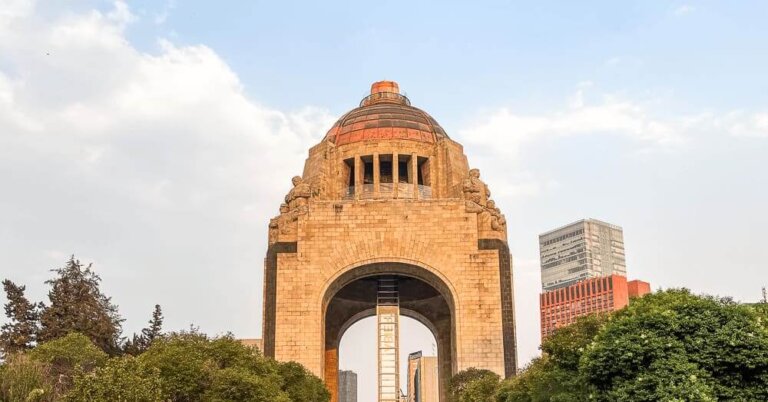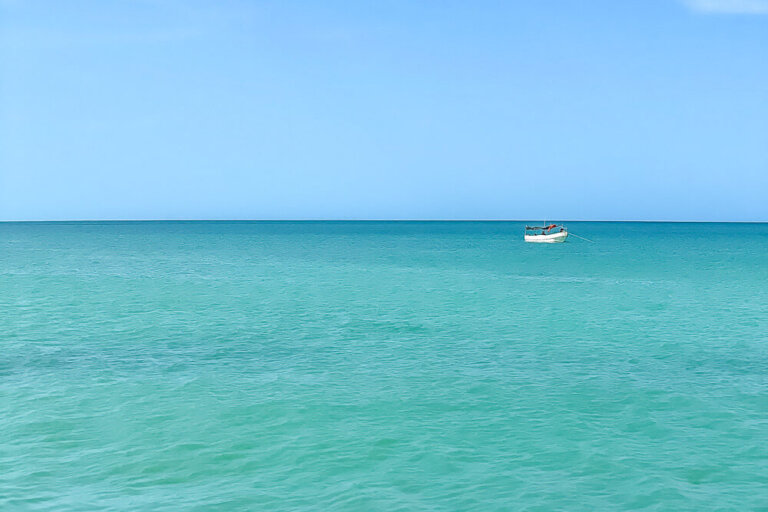This post may contain affiliate links, which means I’ll receive a commission if you purchase through my links, at no extra cost to you. Please read full disclosure for more information.
Forget off the beaten path for a minute.
If you are looking for a fun weekend afternoon, living la vida loca with a bunch of happy Chilangos (Mexico City natives), then head to Xochimilco.
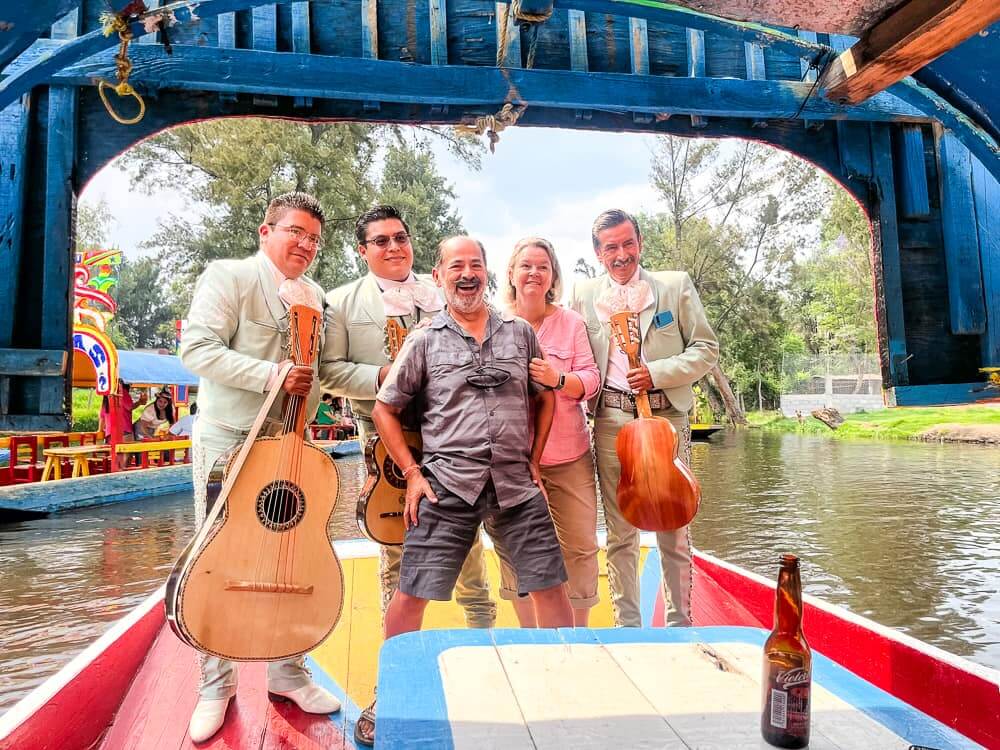
Xochimilco (pronounced so-shee-MEEL-co) is a Nahuatl word meaning some version of “the land of flowers”. Indeed it is a surprisingly fertile agricultural area in the southern reaches of Mexico City.
Once in Xochimilco, you will find yourself on a colorful trajinera (flat-bottomed boat) in no time, cruising through the chinampas (commonly referred to as floating gardens), listening to mariachis while you sample the local offerings of food and drink.
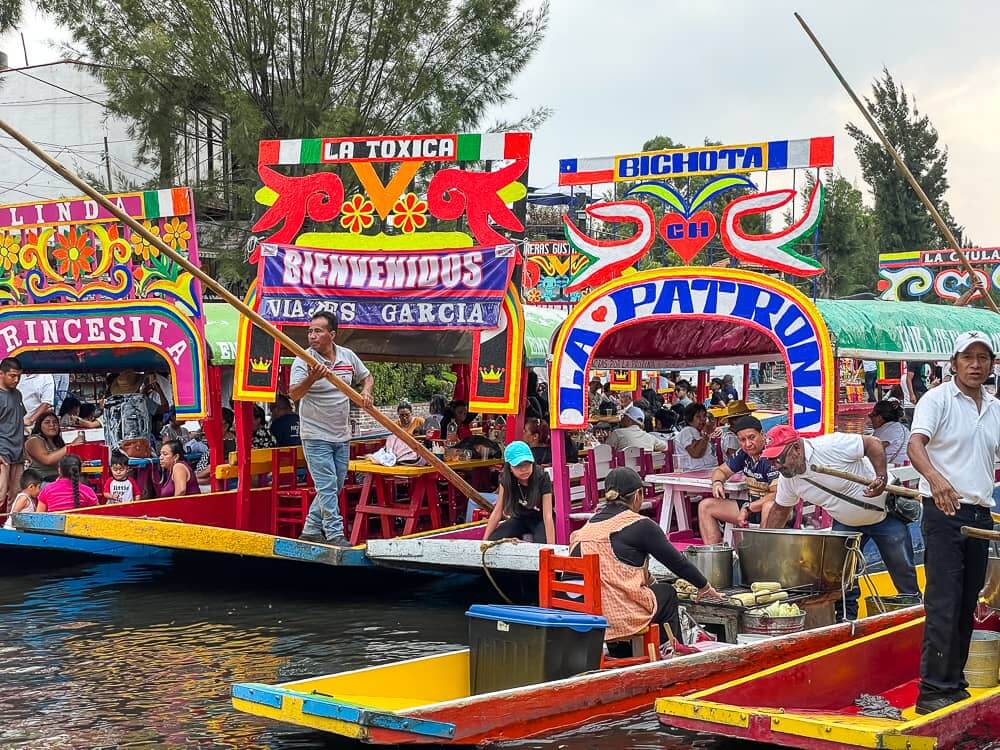
It seems super-touristy, and it is, but there are waaaay more locals than foreigners, so I think it still counts as an authentic cultural experience!
It’s also worth noting that UNESCO has inscribed the Historic Centre of Mexico City and Xochimilco into its World Heritage site list, citing that Xochimilco, “with its network of canals and artificial islands, it testifies to the efforts of the Aztec people to build a habitat in the midst of an unfavourable environment.”
Before you go, I think you should learn a little about what makes the chinampas special. And I will also give you the information you need to plan your own afternoon in Xochimilco, whether you want to DIY it or leave the planning to someone else!
Don’t feel like planning a day in Xochimilco by yourself? Join a tour and let them take care of all the details!
About the Chinampas of Xochimilco
So, what are the chinampas?
The Chinampas are often referred to as the Aztec floating gardens.
But they are not really floating anymore. They are actually man-made islands. Thousands of years ago the Xochimilcas (and later the Aztecs) formed these islands on the shallow lake beds of Xochimilco by braiding reeds and placing them in orderly plots underwater to collect sediment and plant matter. As sediment floated by in the canals, it would get trapped in the reeds, gradually building up a base of nutrient-dense soil above ground.
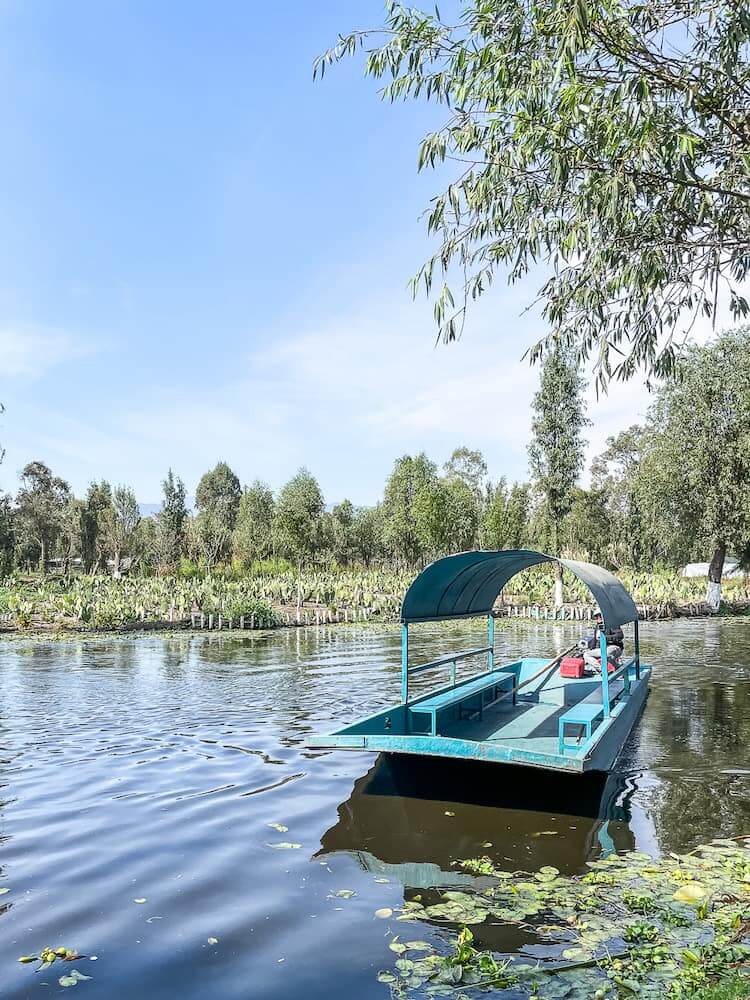
The Aztecs would then plant their traditional crops of corn, beans, squash, tomatoes and chili peppers on these fresh plots of land. They had plentiful irrigation from the surrounding fresh water. The farmers continued to add to the soil by dredging more nutrient-rich soil from the lake beds (and also reported using human waste from the big city as a fertilizer). It’s a complete ecosystem that provides incredibly rich soil year in and year out.
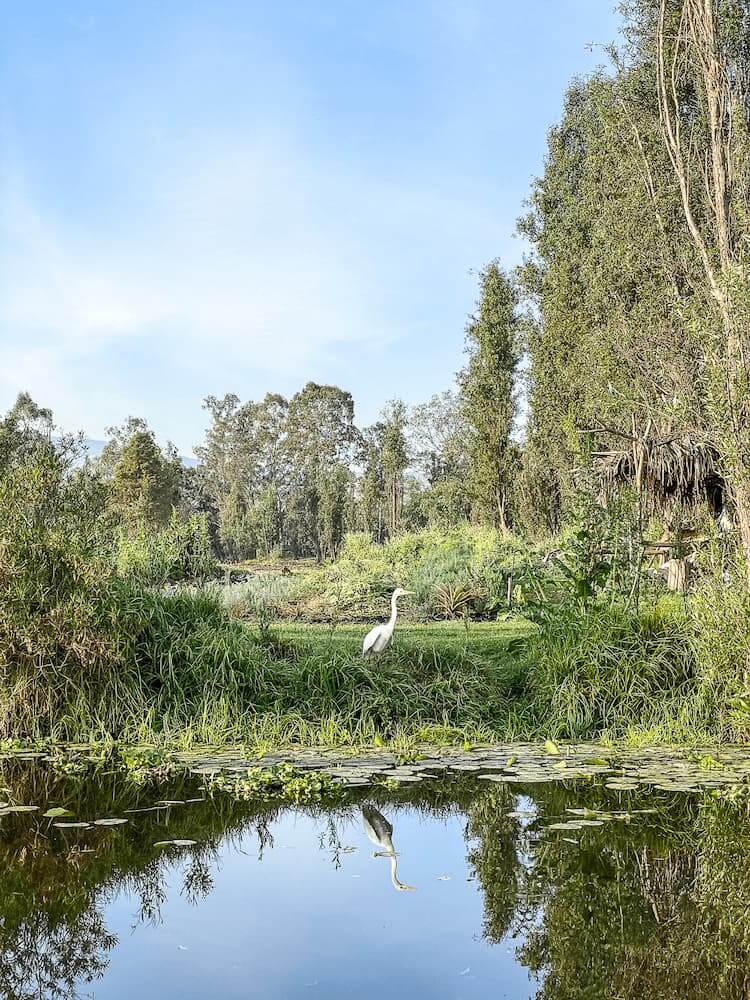
As Mexico City has expanded and sucked up all the water, the chinampas have been greatly threatened. Today, locals are fighting to retain what remains of their agricultural traditions, and what remains of their land.
The shut-downs of COVID-19 actually helped the chinampas have a moment. When all of sudden Mexico City residents weren’t sure where they would get their food, they turned to their local chinampa producers. And the chinamperos stepped up! New networks appeared to connect people to this “new” food source. And finally, things started looking up for the future of the chinampas revival movement.
If you want to skip the party boat and experience farming in the chinampas, I highly recommend you check out Arca Tierra: A Magical Sunrise Experience in the Chinampas of Xochimilco.
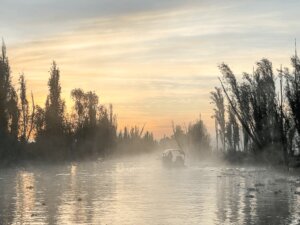
Trajineras of Xochimilco
The colorful trajineras have become the symbol of Xochimilco, perhaps even overshadowing the importance of the place itself. While this practical style of flat-bottomed boat, propelled only by a long pole, has been used to navigate the chinampas for hundreds of years, they didn’t always look so pretty.
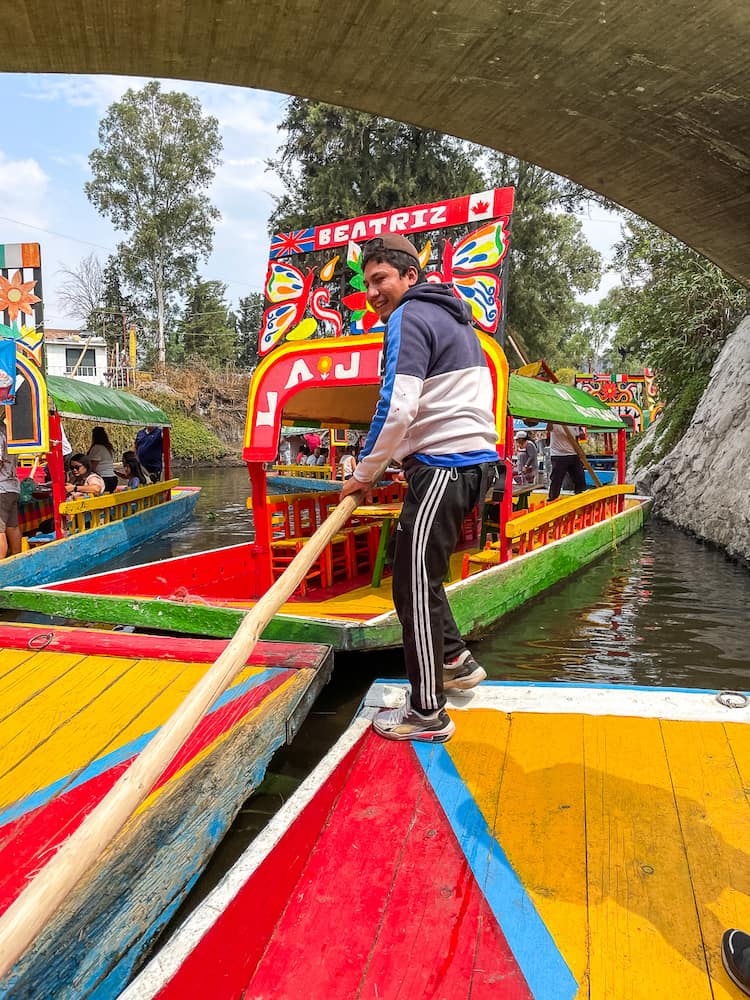
In the early 1900s Xochimilco became popular as an escape from the city for the sharply-dressed aristocracy (los Catrines) during the time of Porfirio Diaz. They started to fancy up the boats for the richie riches, adding seats and a roof for shade. Then they added the bright colors to reflect the area’s flower-growing culture, and the final touch of adding the Catrine’s wife or girlfriend’s name in big letters.
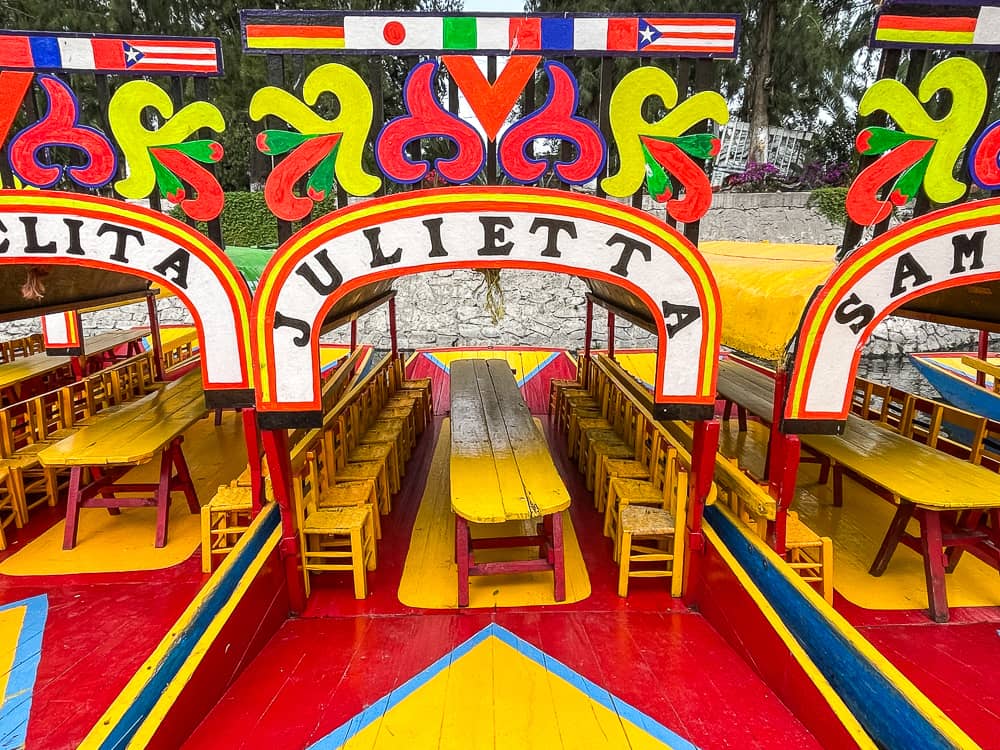
They also reforested parts of the Nativitas area and constructed new boat launches to accommodate all this new activity.
The Catrines have come and gone, but the tourists and the trajineras remain. Let’s hop on!
Boat Rules and Regulations
Believe it or not, the trajineras are actually highly regulated. The government annually sets a maximum hourly price for boat rentals (MX$750 as of August 2024) and sets a maximum number of passengers on board (usually 18).
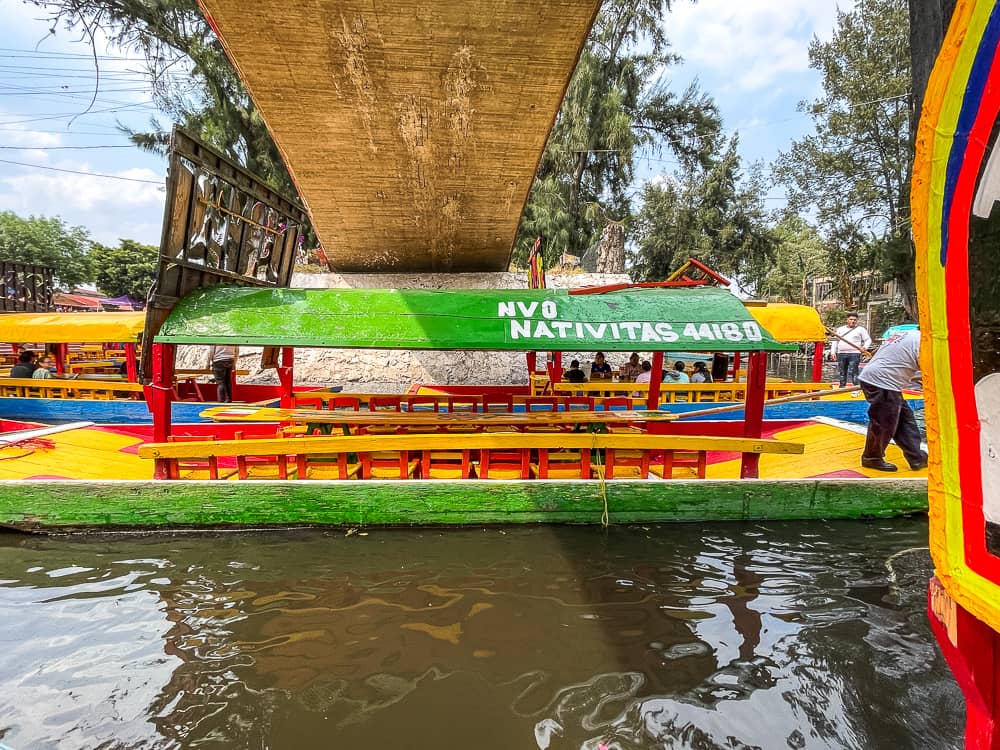
There are also rules about alcohol consumption and acceptable behavior while on board. If you care to peruse these rules yourself, check out the government regulations.
Embarcaderos (boat launches) of Xochimilco
If you do even a little research, you’ll soon find out there is no one “Xochimilco”. In fact, there are quite a few embarcaderos where you can hire a trajinera. Your choice of embarcadero might be influenced by whether you are looking for a “traditional” or “ecological” tour, and whether you plan to take public transportation or a taxi/Uber.
I have highlighted a few of the more popular ones here, but the Mexico City website has information on all the embarcaderos.
Traditional Trajinera Boat Tours (aka Party Boats)
Traditional tours, as the name implies, stay in the more central areas of Xochimilco and offer a classic experience with vendors and musicians.
- Nativitas Embankment:
- Embarcadero Nuevo Nativitas
- Embarcadero Las Flores Nativitas
- Embarcadero Belem and Belem de las Flores
- Embarcadero Caltongo
- Embarcadero Salitre
Ecological Tours
Ecological tours might offer less of a crowded party atmosphere and take you further into the canals where you can see more wildlife and get a better sense of life in the chinampas.
- Embarcadero Puente de Urrutia
- Xochimilco Ecological Park
- Embarcadero Cuemanco
- Michmani Chinampa
- Lago de Los Reyes Aztecas (Lake of the Aztec Kings)
- Embarcadero Fernando Celada
So far I have only been to Nueva Nativitas and Cuemanco, so I’ll share my experience there, as well as two other embarcaderos that are actually a little easier to get to on public transportation: Belem / Belem de las Flores and Fernando Celada.
Embarcadero Nuevo Nativitas
The most popular embarcadero is Embarcadero Nuevo Nativitas, one of three launches along the Nativitas Embankment.
This is the one we went to, and I recommend it if you are looking for a full-on party atmosphere (at least on weekends).
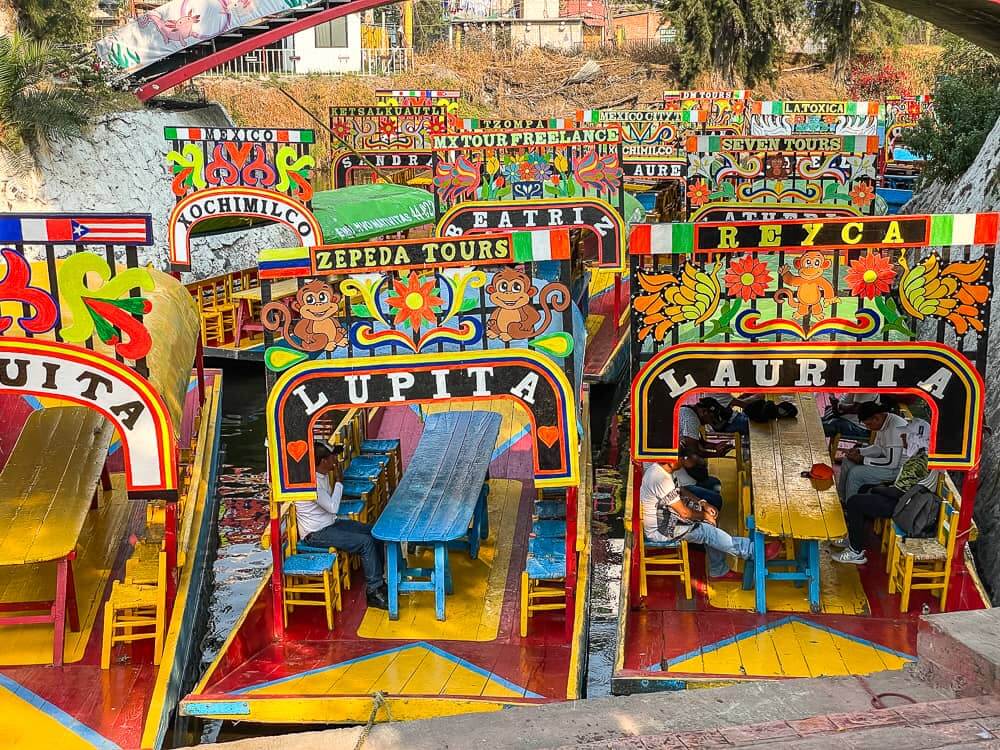
The Embarcadero Nuevo Nativitas has been around since 1970 but has been spruced over the years. It has a well-developed port area with plenty of parking, shops, vendors, and restaurants. There are about 220 boats for you to choose from. (Though you don’t really get to choose a boat—one is assigned to you.)
On a weekend, the canal is choc-a-bloc full of frolicking Chilangos and tourists. You will have your choice of food and drink vendors and mariachis. You can also hop off and enjoy mini-museums and other attractions along the wayside.
Note that you can take ecological tours from here, but it usually takes 5-6 hours. I’d pick a different spot if you want an ecological tour.
Getting to Embarcadero Nuevo Nativitas
From Condesa or Roma, expect a 45-minute to 1-hour drive (it’s 30 kms south of downtown). An Uber will cost around MX$400.
On public transit, take the Tren Ligero (light rail) to Xochimilco. Then it is still a little ways from the Xochimilco light rail station to the Embarcadero. Your best bet will be to take a 15-minute taxi or Uber ride. Walking or taking a bus will take about 30 minutes.
Embarcadero Belem / Embarcadero Belem de Las Flores
Embarcadero Belem de Las Flores is the embarcadero closest to the light rail station. It’s about a 10-minute walk, which makes it super convenient.
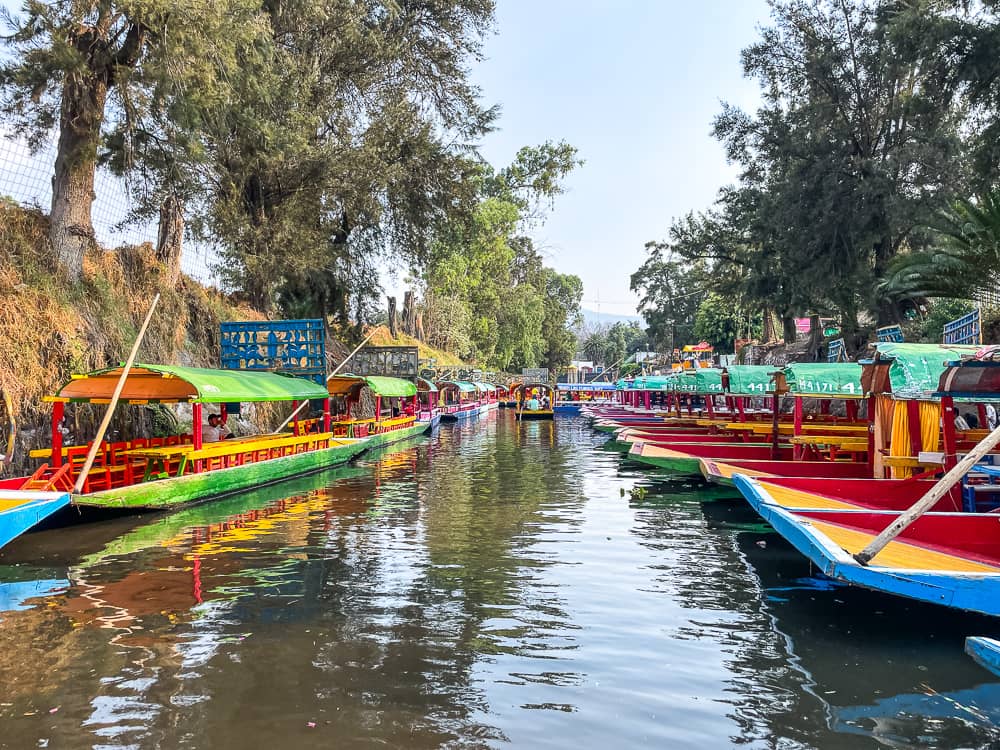
But it doesn’t get great reviews, with a lot of complaints about people feeling like they were getting scammed (though in some cases it seems like they just didn’t know how pricing works). It’s probably similar to the others!
Embarcadero Belem and Embarcadero Belem de las Flores share an embankment on the old Cuemanco Canal. It’s easy enough to find both embarcaderos if you look for the colorful arches off the Calle Violeta in downtown Xochimilco.
If you are looking for an ecological tour from here, expect a 4-5 hour trip.
Embarcadero Cuemanco
Opened in 1993, Embarcadero Cuemanco is a more mellow embarcadero, near the Parque Ecologico de Xochimilco. Parque Ecologico de Xochimilco is the largest park in Mexico City after Chapultepec. The Parque Ecologico hosts a large flower and plant market with a wide assortment of plants.
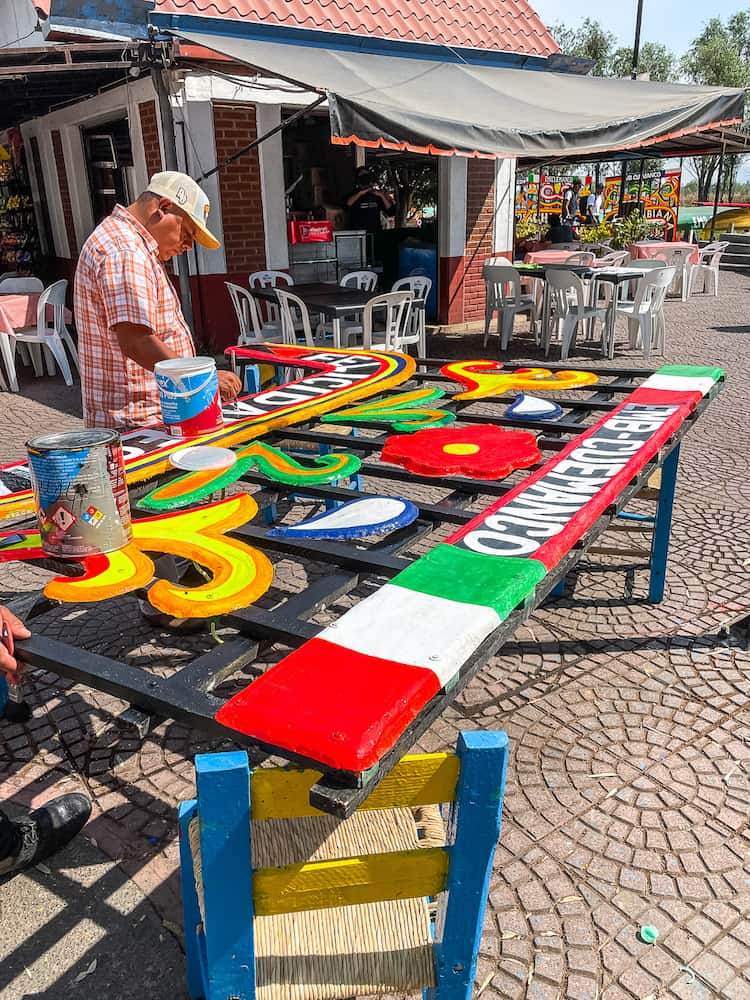
One thing I noticed at Embarcadero Cuemanco were large signs that describe various tour options. You still have to hire the whole boat, but at least it gives you an idea of pricing and duration.
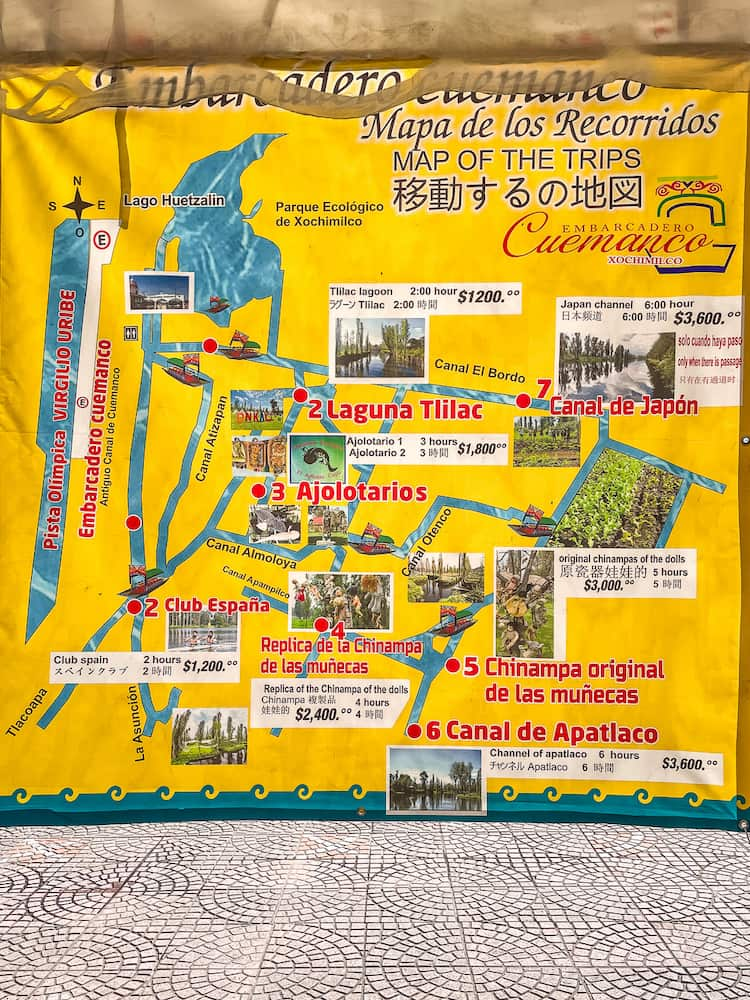
There are a few spots here to check out axolotls, including the Ajolotario “El Carrizal”.
This is also the embarcadero near the meeting point for the Arca Tierra experience, so it’s a great option if you want to have both a traditional and ecological experience in one day.
Getting here by public transportation will take you around 2 hours from central CDMX, and will require a bit of walking. Your best bet is an Uber. Taxis are readily available at the Embarcadero.
Embarcadero Fernando Celada
Opened in 1968 as part of the Olympics effort, the Embarcadero Fernando Celada is relatively easy to get to, as it’s only about a 10-minute walk from the Francisco Goitia or Xochimilco light-rail station.
The Embarcadero Fernando Celada has a lot of land-side services, including bathrooms and parking, which means it is often a starting point for larger tour groups.
On some nights they host special “Lunadas” (night-tours) from 8 p.m. to 10 pm, though it’s difficult to get information about these events. If you can find one (and I couldn’t) I’d recommend joining a tour for a night trip to Xochimilco. It’s also probably easier and safer to get to and from Xochimilco at that hour with a tour.
Isla de las Muñecas / Island of the Dolls
The Island of the Dolls (warning: sketchy ads on this website) is creepy famous for its doll bodies and heads hanging off trees and tucked into nooks and crannies in the woods.
But how do you get to see it for yourself?
If Island of the Dolls is high on your priority list, your best bet is to book a tour that specifically states it will take you to the Island of the Dolls. The Embarcadero Cuemanco and Embarcadero Fernando Celada are recommended for easiest access to the Island.
A tour that includes Island of the Dolls will take longer an cost more—but I bet it’s worth it!
If you look for Isla de las Muñecas / Island of the Dolls on Google maps, a few locations will pop up. I’ve heard there is one original and a few imposters…so I am going to try to figure out the best options next time I go to CDMX. I will report back.
Axolotls
By now I’m sure you have heard of axolotls, cute creepy little creatures that lurk in the chinampas. But they don’t lurk much anymore, as they very existence is endangered. Locals blame their decline on the introduction of tilapia into the waterways (as a food source).
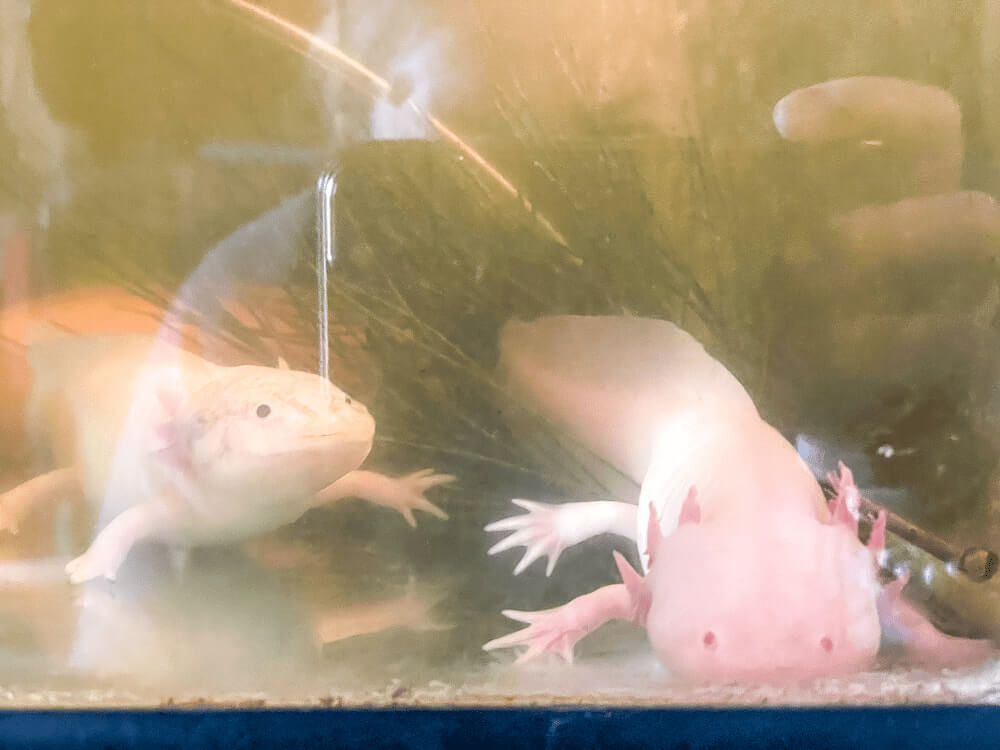
There are many efforts underway to preserve axolotls, and hopefully reintroduce them to the chinampas. These efforts are both formal (Museo del Axolote and ANFIBIUM: Museo del Axolote y Centro de Conservación de Anfibios in Chapultepec Park) and informal. You’ll find mini-museums along the canals where for a small fee (around MX$50) you can pop in and check out tanks with pink and black and brown axolotls.
Planning Your Visit
Getting to and from Xochimilco is going to be the trickiest part of your trip to Xochimilco. Once you are there, everything is relatively easy, though it might feel confusing at first. An official-looking guy will connect you with a boat, you will tell them how long you want to go for, agree on the price, and off you go.
Information
Depending on your boatman, you will get more or less information on the area you are going through. Most of them speak some English (it’s good for business). I’m sure if you have questions about the area you are riding through, they will be happy to answer questions.
Accessibility
I don’t know how they did it, but I did see someone in a wheelchair on a boat, so it can be done!
Hours
The Embarcaderos are generally open from around 6am to 10pm on weekends. Activity at the embarcaderos typically shuts down closer to 6pm during the week. If you want the full party atmosphere the sweet spot is in the afternoon into the evening, especially on weekends.
Check the official Mexico City website if you want to find out the hours for a specific embarcadero.
Cost
So, you are wondering…how much does an afternoon at Xochimilco cost?
An afternoon at Xochimilco can add up pretty fast. A lot of things like hiring the boat and mariachis are the same no matter how many people you have. So, the more people you have to split the costs the better. It’s also more fun with more people, so win-win!
You should expect to spend a minimum of MX$2000 (around US$100, give or take, depending on exchange rates) to get to Xochimilco and spend a few hours cruising the canals. This minimum is for up to 18 people, so it could be a pretty good deal if you have a lot of friends. The cost of food, drink, and entertainment is on top of that.
If you are a solo traveler, or even a couple, it’s a no-brainer to save money by hopping on a tour. Honestly, it would feel kind of weird to be cruising around in a trajinera solo (but you do you).
Come prepared with a handful of CASH for the full Xochimilco experience. Everything is cash. You might find an ATM…but you might not.
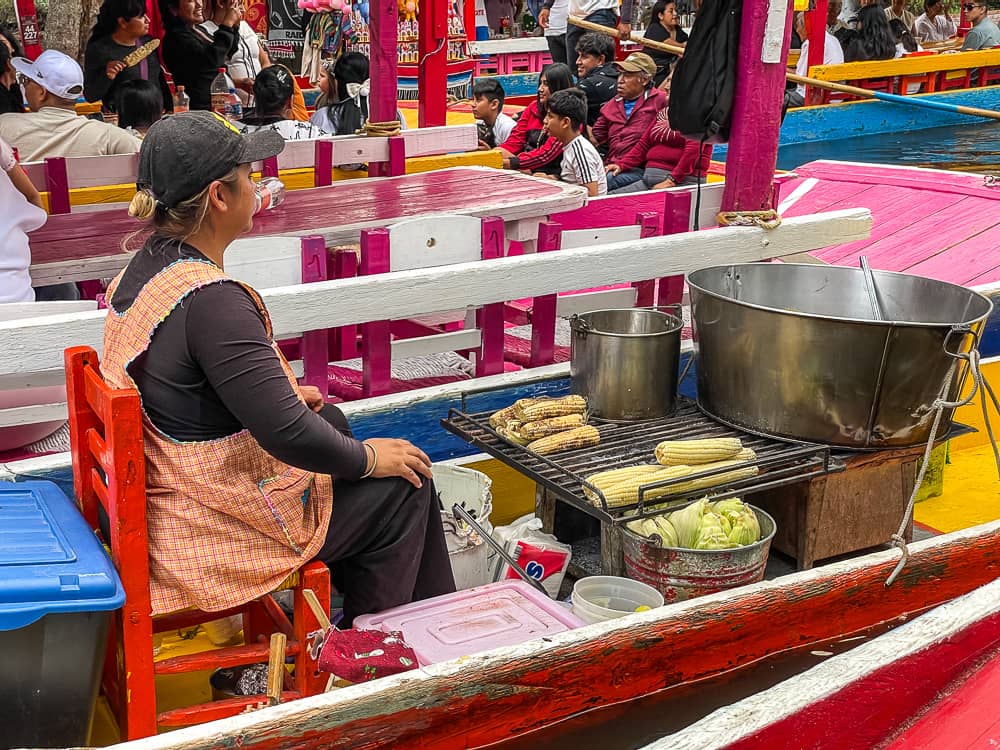
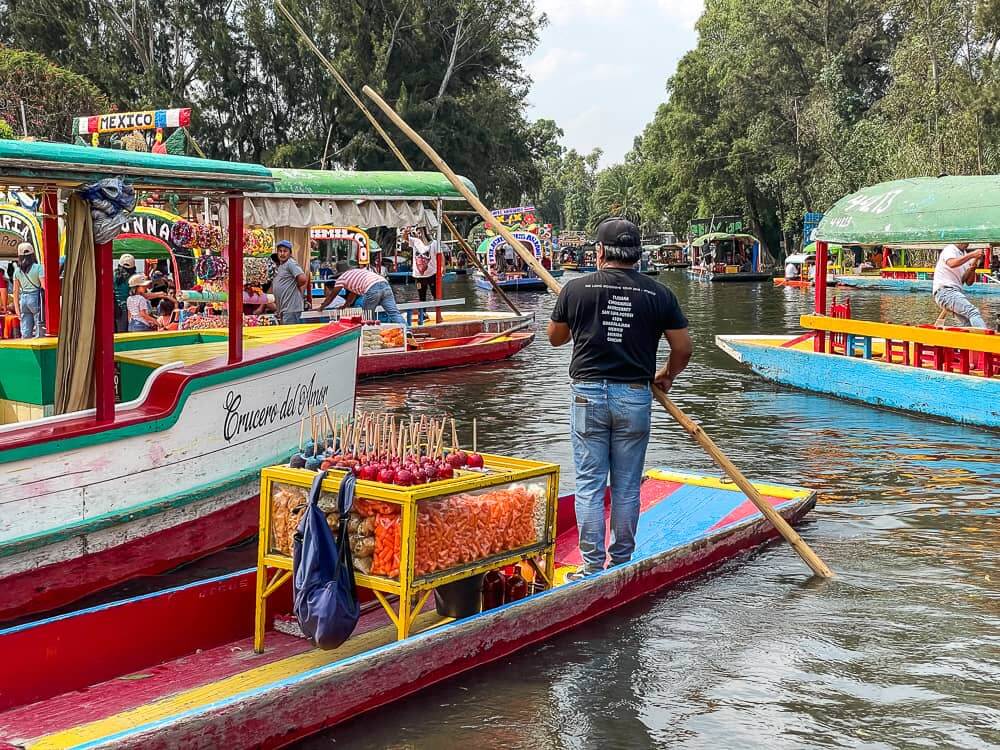
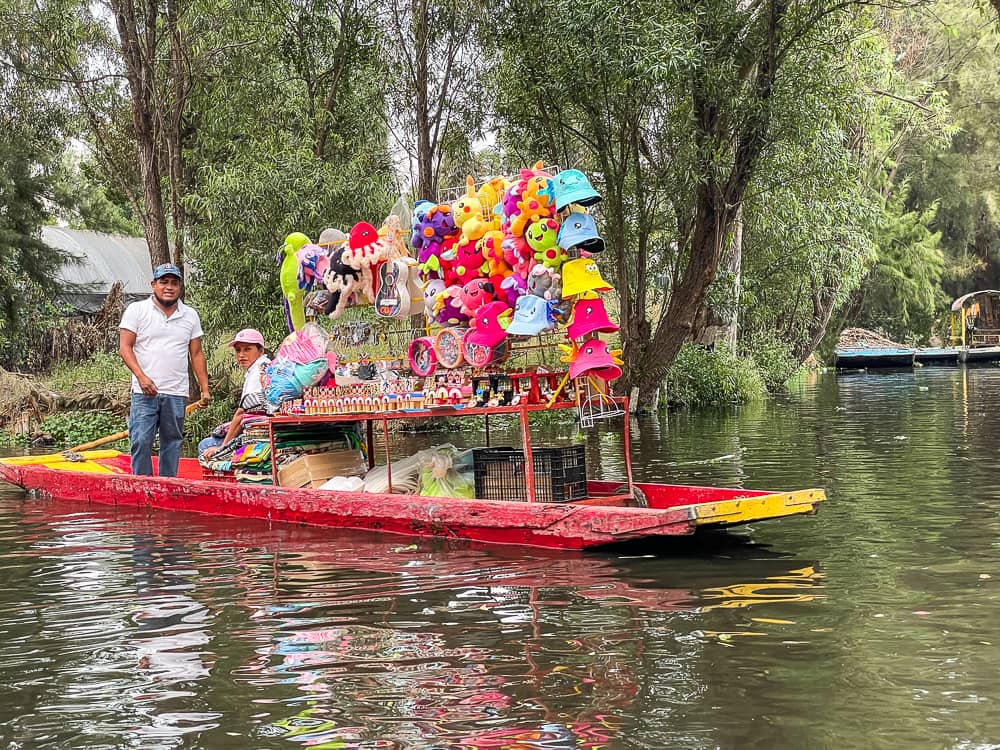
I don’t want you to be shocked by some of the eye-popping prices, so here is a brief rundown of typical costs at Xochimilco. Costs listed below are as of August 2024 (many costs are regulated by the government and updated annually). If you want more detail, check out my article how much does an afternoon at Xochimilco cost.
- Trajinera (boat): MX$750 per hour, suggested MX$300 tip.
- Musicians: MX$170-300 per song. Mariachis are the most expensive, and they hop on your boat to play!
- Drinks: MX$40-150 for beer (depending on size), MX$30 for soda or water
- Food: $MX110-130 for a single quesadilla, sope, tlacoyo, or tostada or $MX230 for a platter. MX$45 for elotes (corn on the cob), esquites (corn in a cup), chicharrones (fried pork rinds), or manzana acaramelada (candy apple).
- Flower crowns: MX$150 for plastic, up to MX$250 for the ones made from real dried flowers. You know you want to look pretty for the ‘gram!
Definitely ask the price before you say yes to anything. And if you are on a budget, bring your own food and drink and just enjoy other people’s musicians.
Getting There
Listen, Xochimilco is far from downtown Mexico City. It is going to take you at least one hour to get there, no matter how you go. It will probably take closer to 1.5 to 2 hours by public transit.
If you want to take public transit, your best bet is to take the Metro to Tasqueña (blue Metro Linea 2), then hop on the light rail 1 to Xochimilco. From there, it’s still quite a ways to the Embarcadero Nuevo Nativitas or other embarcaderos. You can take a taxi or uber, or find a green microbus to take you to your embarcadero. You might also be approached by runners hired by the various embarcaderos who will offer to take you to their embarcadero. If they are going where you want to go and the arrangement sounds reasonable, go for it.
Of course, an Uber, Didi, or taxi will take you directly to the embarcadero of your choice. Prices, of course, vary depending on where you start, time of day, surge pricing etc. But expect to pay MX$200-400 (before tip).
Pro tip: An afternoon in Xochimilco pairs well with a morning in Coyoacan (and Frida Kahlo’s Casa Azul), since you are already halfway there once you are in Coyoacan. You might even slip in a visit to Museo Anahuacalli on the way.
Final Thoughts
It may seem ticky tacky, but an afternoon at Xochimilco is actually a great way to immerse yourself in the local culture. There are a few gringos out there, but it’s mostly Mexican families celebrating a birthday, a wedding, or just a weekend out. People are just out having fun, and it’s a beautiful sight.
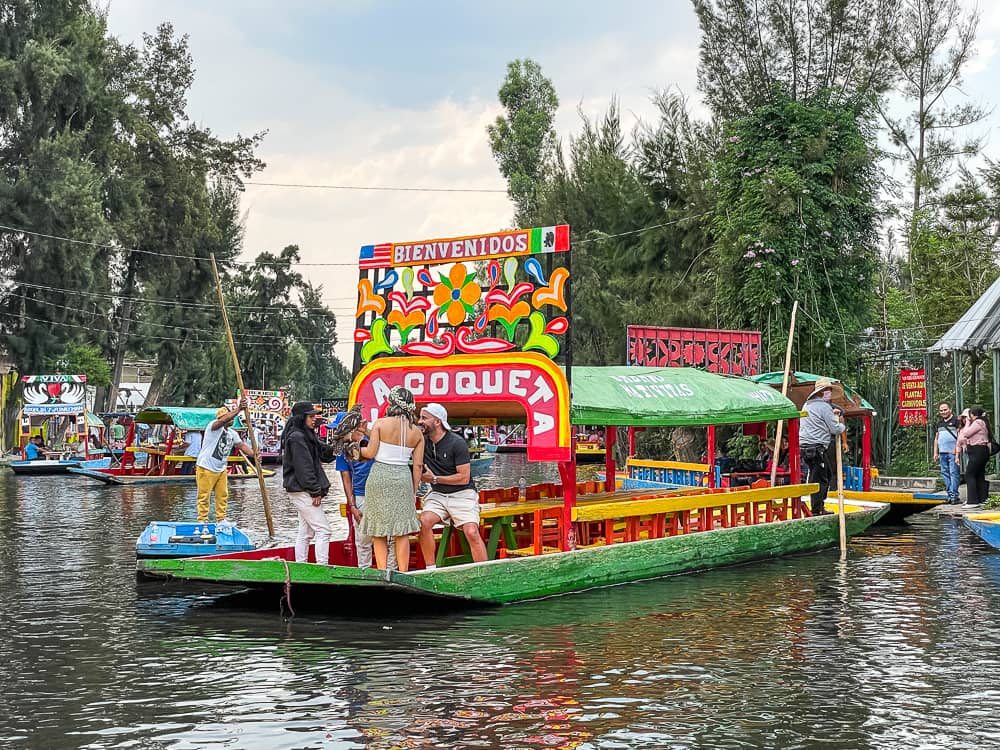
Buuut, if floating on a party boat for a few hours really isn’t your thing, but you still want to check out the chinampas of Xochimilco, I highly recommend the sunrise experience with Arca Tierra.
Or perhaps you might enjoy doing both! You can actually hop on a party boat at the Embarcadero Cuemanco after you complete your Arca Tierra experience. Having experienced both on separate visits, however, I do think the party boat experience would be quite jarring after the zen experience of sunrise in the Chinampas.

